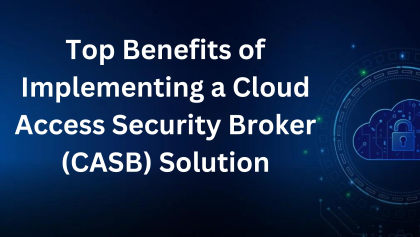Top Benefits of Implementing a Cloud Access Security Broker (CASB) Solution, Top CASB solutions offer comprehensive visibility and monitoring of cloud application usage. For example, they can scan all files uploaded to the cloud and check for sensitive information using data loss prevention (DLP) policies. They also help IT teams find unsanctioned applications or shadow IT, enabling them to remediate any misconfigurations that could leave the organization vulnerable. They can also detect and shut down risky file sharing.
Increased Visibility
In a multi-cloud environment, visibility into data usage across multiple software-as-a-service (SaaS) applications is essential. CASB solutions, which serve as security policy enforcement points, can detect where sensitive data is stored and how it’s shared. They also can monitor telemetry data to identify new connections trying to access data.
The visibility offered by a cloud access security broker makes it easier for organizations to enforce compliance and security policies. This can be accomplished in several ways, including by preventing the unauthorized exfiltration of data through file-sharing features such as Dropbox or Google Drive and by implementing role-based access controls to prevent unauthorized users from accessing sensitive data. Additionally, a CASB can help to discover and control shadow IT by monitoring unauthorized SaaS apps that may be being used in the organization without the team’s knowledge or approval and by enabling the correct action to be taken to bring those accounts under control. The ability to see the full range of activity occurring in managed and unmanaged cloud services is important to enterprises. This is because many cloud threats are launched from unsanctioned or unmanaged devices. As such, the ability to take a scalpel rather than a hammer and block the use of services completely is critical to avoiding data loss and meeting compliance requirements.
Enhanced Security
A CASB provides a crucial layer of security between cloud-based applications and employees. As the first step in a comprehensive security network, including firewall as a service and secure web gateways (SWG), CASB solutions deliver cloud malware detection and prevention, data loss prevention (DLP) and cloud application visibility and control.
By acting as a security checkpoint between cloud application users and enterprise systems, CASBs help organizations discover cloud applications used by employees, enforce security policies and comply with regulatory requirements. CASBs are especially helpful when protecting sensitive information in the cloud because they can detect and block malware, phishing, social engineering and unauthorized file sharing that attackers commonly use to gain entry into corporate networks and steal confidential data. Advanced CASB solutions enable organizations to protect their data, whether it’s in sanctioned or unsanctioned clouds. Using techniques like autodiscovery, device profiling and risk assessment, a CASB can identify unsanctioned cloud services hiding critical data such as proprietary information, credit card numbers or health records. A CASB can also protect sensitive data in transit by encrypting it, removing readable metadata or sending it to a secure storage location such as on-premises servers or encrypted mobile devices. Moreover, a CASB can prevent data leaks by blocking unauthorized downloads and shutting off apps with inappropriate permissions.
Better Compliance
When organizations rely on cloud infrastructure to support their users, they face various security challenges. CASB solutions help protect data in the cloud from security threats, ensure compliance, and enforce policies. Unlike on-premises data loss prevention tools, a CASB solution works in real-time to identify and protect sensitive data in sanctioned and unsanctioned cloud applications and various devices.
Many security experts consider a CASB solution a vital addition to their cloud security strategy because it helps them address security gaps associated with third-party platforms outside the company’s control, such as cloud storage or collaboration services. CASBs enable enterprises to securely enable managed and unmanaged cloud applications by leveraging features like granular access control, data-at-rest encryption and encryption-in-transit for data in motion, and threat protection capabilities. When shopping for a CASB, consider the functionality of each solution, such as how well it integrates with your existing identity access management and single sign-on systems and whether it supports both forward proxy and reverse proxy modes. Look for CASBs that provide visibility and control over cloud application usage by enabling them to see what’s happening inside sanctioned SaaS and unsanctioned apps, identify data movement between cloud services, and validate user identities.
Reduced Risk
The CASB provides visibility, security access control, threat detection, and mitigation for the organization’s cloud infrastructure. It operates as an extension of the company’s existing defenses and is deployed as software or hardware. The centralized view and automated access controls provided by a CASB enable organizations to mitigate risk by ensuring that all cloud services, apps and data are managed according to company policies. In addition, a CASB can detect and prevent data loss by enforcing policy-based encryption and other measures to secure cloud-based files.
Additionally, a CASB enables organizations to reduce the risks associated with remote workforces. Employees can unintentionally create security threats by adopting unsanctioned software or moving sensitive information to personal cloud storage, which puts the company at risk. A CASB can identify these risks, help IT teams stop shadowing IT, and train employees on best practices for cloud usage.
A CASB solution can also protect against insider threats, including those caused by negligent or malicious actions. CASBs can identify the origin of a threat by analyzing logs and behavioral patterns and automatically notify IT teams when suspicious activity is detected. They can also identify potential malware and other attacks by leveraging data from their global research and third-party feeds. This helps companies detect and respond to attacks quickly, thus reducing the potential impact of a data breach.
